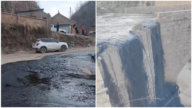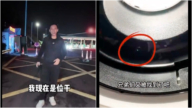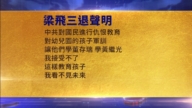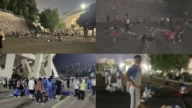【新唐人2012年8月27日訊】近期,河南開封計劃「千億再造汴京」,打算將開封市的老城區改造成近20平方公里的旅遊區,重現北宋「汴京」。而兩年前開始,在大陸西部和東部地區,那些被外媒注意到的大量新興豪華城市,由於建築物大量空置,被稱為「空城」或「鬼城」。現在媒體關註:開封是否會成為下一個造城衝動下的「空城」?下面聽聽專家怎麼說?
開封市政府提出的「千億再造汴京」計劃,是想藉助開封市作為宋代古都的歷史資源,主攻文化旅遊。但是據媒體報導,開封的這項「 復古」計劃,僅拆遷費就耗資1000億元,古城區8萬居民將被迫拆遷,媒體認為,這對年財政收入不足50億元的開封市而言,無疑將是一場豪賭。
中國藝術研究院學者吳祚來指出,地方政府很多不是用一種平常心來對待古建築和傳統文化,更多的是在利用。拆除民房,建設虛假古蹟,其實破壞了另外一種生態,就是百姓生活的生態。老百姓已經在這裡住了幾百年了,當局對他們強行拆遷,這侵犯的是人權。官員要得到的其實是他的經濟利益,他並不是為了復古。
中國藝術研究院學者吳祚來:「一個領導在這裡三五年,通過強拆,賣地皮,假文物的建築,來與開發商達成一個聯盟,趕快把這一筆錢拉到。這是他們最根本的動機和目地。真正的維護這個城市的建築,他是有長遠的規劃,他不是強行的剝奪別人生存權的方式,一夜之間就把一個地方毀了,然後幾年之內,建成一個假的文物新城。」
文化評論家葉匡正也指出,當局打著「復興古文化」的旗幟,其實眼睛盯著「賣地」的收入。
文化評論家葉匡正:「其實現在很多地方政府,因為各地地價大漲,很多商家可能看中了一些古城,旅遊資源比較豐富的這些城市的土地資源,所以以各種名義,開封(政府)看中的其實更多的是土地帶來的收入。」
據《中國經營報》報導,幾年前,開封以治理「龍亭風景區」周邊環境的名義,開始動遷這個區域﹔最近兩年,「迪臣置業」公司已經在這裡開發了十幾棟高端住宅。
但是報導還說,在開封「鼓樓」原址,看到一個深約15米左右的大坑。「鼓樓」是開封標誌性的古建築,現在,原來的鼓樓基座已經被搬走。據說這個大坑裡面要建造一個巨大的地下商城。這種通過毀壞一個城市的歷史文案製造的是贗品,沒有真正的文化價值。
兩年前,美國傳媒在網上展示了一些他們稱為「鬼城」的衛星圖片,因為城市中大量的住宅和街道空空蕩蕩,人煙稀少,令人疑惑。據了解,近年來,大陸許多地方政府為了追求GDP等政績,製造了許多無人居住的「空城」。
如,河南鄭東新區「遠景概念」規劃範圍150平方公里,整個工程將近2000億,但房屋空置率達90% ﹔而被譽為「亞洲最大別墅區」的天津「京津新城」,總規劃面積25000畝,可供50萬人生活、居住、娛樂。5年來,開發商在這片土地上營建起1000座高端別墅,但這還不及「京津新城」總體規劃開發量的1/10。目前入住率只有10%。
那麼,開封的「造城」計劃到底是惠民工程還是政績工程?民眾發出了質疑,認為:開封當局的做法不切實際,是「沒有魂的復古」。
採訪編輯/秦雪 後製/鍾元
Kaifeng plans to restore historical outlook of Song Dynasty at
100 billion Yuan, speculated to produce another “ghost town”.
Recently, the city government of Kaifeng in Henan province
presented a restoration project costing over 100 billion Yuan.
The project plans to transform its old town
into a 20-square-kilometer tourism zone.
This is to restore the historical outlook of “Bianjing” city,
the capital of Northern Song Dynasty.
For the past two years, foreign media have reported that
many Chinese cities where buildings are newly developed
are seldom used so that they look like “ghost towns”.
Similarly, Kaifeng’s project has been speculated
to produce the next “ghost town”.
Another unrealistic project of city building.
Kaifeng’s project of “restoration of Bianjing outlook”
aims to develop tourism with the city’s historical background
as the capital of the Song Dynasty.
However, according to media reports, just the demolition
fee of this “restoration” project will cost as much as 100 billion.
More than 80,000 residents of old town will be forced
to move.
Some media report remarked that the project is an
extremely dangerous gamble for Kaifeng city.
Their annual revenue is less than 5 billion Yuan.
Scholar of China Academy of Art, Wu Zuolai remarked that
most local governments wanted to benefit from ancient
architecture and traditional culture rather than appreciating their historical value.
Replacing civilian houses with fake historic sites actually
destroys the social ecology of civil life.
Most residents’ families have lived there for hundreds of years.
Demolition of their houses is violation of human rights.
Wu said what the Chinese Communist Party(CCP) officials
real aim is economic value, not restoration of history.
(Wu Zuolai, scholar of China Academy of Art): “Each
municipal leader will stay in his position between 3-5 years.
They try to earn money in this short period by collaborating
with developers in demolishing civil houses, selling lands
and building fake historic sites. Money is their ultimate goal.
A real restoration of historical architecture will not be like this.
It won’t destroy an area by depriving local residents of their
basic rights to build a fake 『historic town’ on their land.”
Cultural commentator Ye Kuangzheng also remarked that
while purporting to “restore traditional culture”, the CCP
only really cares about the income from land sales.
(Ye Kuangzheng): “Since the price of land has
sharply increased recently,
many developers are interested in the land from
the cities with tourism resources such as historic sites.
Therefore local governments try to sell those lands
in different ways.
In fact Kaifeng government also wants to earn
this income from land sales.”
According to China Business News,
the city government of Kaifeng started to demolish
civil houses in Longting Scenic Area several years ago in the name of “improving environmental quality”.
In recent two years, a corporation called Dichen Group Ltd
has developed tens of luxury homes in the area.
The report also revealed that a big hole of 15-meter depth
can be seen at the former site of Kaifeng’s Drum Tower.
The Drum Tower is a signature ancient architecture of Kaifeng,
but its foundation has been removed.
It is reported that the city will build a huge underground
mall in the hole below the tower.
Ye Kuangzheng said that such acts of destroying real historic
sites will only create fake productions with no cultural value.
Two years ago, American media posted on their websites
some satellite pictures of a so-called “ghost town”.
In the picture, most houses and streets are empty with
few visitors, which looks confusing.
It is believed that many local governments in China mainland
had built such “ghost towns” in recent years.
They wanted to generate nice-looking “GDP” numbers.
As an example, the “perspective concept” project in
Zhengdong New District of Henan covers 150 square kilometers at a cost of 200 billion Yuan.
However, more than 90% of the houses are still empty.
The Jingjin New City in Tianjin,
which is called the “largest villa area in Asia”,
covers a planning area of 25,000 properties
for 500,000 residents to move in.
However, only 1000 luxury homes were built in five years,
less than one tenth of the development planning numbers.
Actually only 10% of the houses have been lodged
with residents.
Chinese civilians have questioned whether Kaifeng’s
“restoration project” will benefit civilians. Is it only an image project?
Many of them believe that the project is unrealistic,
attempting to restore the historical image without traditional values within.






























